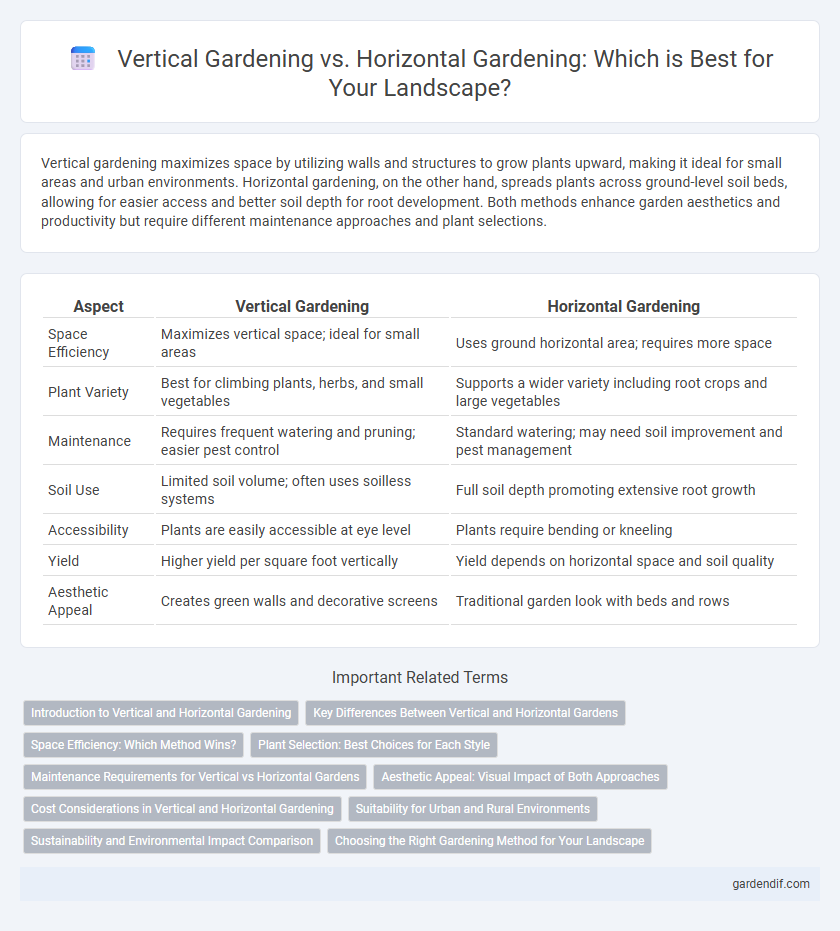
Vertical Gardening vs Horizontal Gardening Illustration
Vertical gardening maximizes space by utilizing walls and structures to grow plants upward, making it ideal for small areas and urban environments. Horizontal gardening, on the other hand, spreads plants across ground-level soil beds, allowing for easier access and better soil depth for root development. Both methods enhance garden aesthetics and productivity but require different maintenance approaches and plant selections.
Table of Comparison
| Aspect | Vertical Gardening | Horizontal Gardening |
|---|---|---|
| Space Efficiency | Maximizes vertical space; ideal for small areas | Uses ground horizontal area; requires more space |
| Plant Variety | Best for climbing plants, herbs, and small vegetables | Supports a wider variety including root crops and large vegetables |
| Maintenance | Requires frequent watering and pruning; easier pest control | Standard watering; may need soil improvement and pest management |
| Soil Use | Limited soil volume; often uses soilless systems | Full soil depth promoting extensive root growth |
| Accessibility | Plants are easily accessible at eye level | Plants require bending or kneeling |
| Yield | Higher yield per square foot vertically | Yield depends on horizontal space and soil quality |
| Aesthetic Appeal | Creates green walls and decorative screens | Traditional garden look with beds and rows |
Introduction to Vertical and Horizontal Gardening
Vertical gardening maximizes limited space by utilizing upward surfaces such as walls, trellises, and fences to grow plants, making it ideal for urban settings. Horizontal gardening involves planting in traditional ground-level beds or containers, accommodating a wider variety of crops with more root space. Both methods enhance greenery and improve aesthetics but differ significantly in spatial use and plant selection.
Key Differences Between Vertical and Horizontal Gardens
Vertical gardening maximizes space by utilizing walls and vertical structures, making it ideal for small areas and urban environments, while horizontal gardening requires ground-level plots or beds with more extensive soil access. Vertical gardens often feature climbing plants, trellises, or wall-mounted containers optimizing sunlight exposure, whereas horizontal gardens provide broad soil surfaces that support root expansion and a wider variety of plants. Maintenance differs as vertical gardens demand regular structural support and irrigation adjustments compared to the traditional watering and weeding tasks in horizontal gardening.
Space Efficiency: Which Method Wins?
Vertical gardening maximizes space by utilizing vertical planes such as walls, trellises, and towers, making it ideal for small urban areas and balconies. Horizontal gardening requires more ground area, which can limit plant density but allows for easier access and larger crop variety. For space efficiency, vertical gardening emerges as the superior method, particularly in environments with limited footprint.
Plant Selection: Best Choices for Each Style
Vertical gardening thrives with climbing plants such as ivy, clematis, and tomatoes, which maximize space and provide lush greenery on narrow surfaces. Horizontal gardening favors root vegetables like carrots, radishes, and potatoes, as well as sprawling herbs and leafy greens that spread across garden beds. Selecting plants suited to each style ensures optimal growth, efficient use of space, and a healthy, sustainable garden environment.
Maintenance Requirements for Vertical vs Horizontal Gardens
Vertical gardening demands more frequent pruning and support system checks to prevent plant overgrowth and structural strain, while horizontal gardening generally requires less intensive maintenance with easier access for watering and weeding. Vertical gardens often involve regular inspection for pests and irrigation system functionality due to their elevated position and concentrated root zones. Soil management in horizontal gardens is simpler, as gravity aids drainage and root expansion, reducing the need for frequent soil amendments compared to vertical setups.
Aesthetic Appeal: Visual Impact of Both Approaches
Vertical gardening creates a striking visual impact by transforming walls and fences into vibrant living art, maximizing green space in urban environments. Horizontal gardening offers expansive, lush landscapes that provide a natural, ground-level aesthetic with diverse plant arrangements. Both approaches enhance outdoor settings, but vertical gardens emphasize height and texture, while horizontal gardens prioritize breadth and layering.
Cost Considerations in Vertical and Horizontal Gardening
Vertical gardening typically reduces land use costs by maximizing limited space through upward growth, which can lower expenses related to soil, water, and maintenance. Horizontal gardening often requires more extensive ground area, leading to higher costs for soil preparation, irrigation infrastructure, and pest control. Initial setup costs for vertical gardens, including structures and support systems, can be higher but may offer long-term savings through improved space efficiency and reduced resource consumption.
Suitability for Urban and Rural Environments
Vertical gardening maximizes space efficiency, making it ideal for urban environments with limited ground area, such as balconies and rooftops. Horizontal gardening thrives in rural settings where ample soil and open land allow for extensive planting beds and crop diversity. The choice between vertical and horizontal gardening depends on available space, environmental conditions, and crop type suitability for urban or rural landscapes.
Sustainability and Environmental Impact Comparison
Vertical gardening maximizes green space by utilizing vertical structures, reducing soil erosion, and enhancing air quality, making it a sustainable option for urban environments. Horizontal gardening typically requires more land and water resources but supports greater biodiversity and soil health through traditional planting methods. Both techniques contribute positively to environmental conservation, yet vertical gardening offers a more efficient use of limited space and resources in sustainability-focused landscape design.
Choosing the Right Gardening Method for Your Landscape
Vertical gardening maximizes space efficiency by allowing plants to grow upward, making it ideal for small or urban landscapes where ground area is limited. Horizontal gardening supports a wider variety of plants and is preferable for larger spaces with sufficient soil depth and sunlight exposure. Assess soil quality, available space, plant types, and maintenance requirements to determine the optimal method for your specific landscape needs.
Vertical Gardening vs Horizontal Gardening Infographic

 gardendif.com
gardendif.com